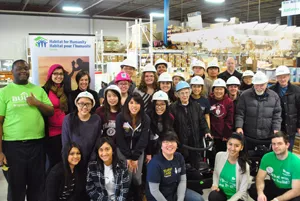
Student Voices: Alternative Reading Week
122 UTM students. 16 community partners. One Alternative Reading Week.
Last week, 122 U of T Mississauga students worked with 16 community partners to give back to the Peel region community, gain skills, and meet other students and professionals. Over the three-day period, students worked with groups including Habitat for Humanity, the Eden Community Food Bank, and the United Way of Peel Region.
The Habitat for Humanity Halton-Mississauga office is neatly tucked into a group of offices that stretch along Argentia Road. At 10 a.m. on Feb. 17, their welcoming staff and volunteers greeted about 30 students.
“Person by person, step by step, we are all making a positive change in this community,” says Alison Canning, volunteer recruitment and development manager at Habitat for Humanity Halton-Mississauga.
Habitat for Humanity is an international non-profit organization that works towards the vision to create ‘a world where everyone has a decent place to live.’ In Halton, 1 in 8 families struggle to own a home and buy food. Habitat for Humanity builds homes on donated land with donated materials, using labour comes from volunteers who donate their time and experience. Families put work into their new home through 400 hours of “sweat equity,” where they work alongside volunteers. Ultimately, families own the homes and pay no more than 30 per cent of their income towards home payments.
Canning says, “What we (at Habitat for Humanity) do is we give people an opportunity to learn, grow, give back, and gain self-confidence. Here, we strive to provide that experience in a safe and inclusive environment. And that’s why we call ourselves a Habitat family. That’s what family’s about.”
In Mississauga, residents can also use the Habitat for Humanity ReStore. The warehouse, attached to the office, sells desks, rolling chairs, book shelves, filing cabinets, and much more. These items are donations from residents and from retailers such as Home Depot, with the profits from sales going directly to building funds. The items, both new and old, are sold at 30-80 per cent off of their retail price and without HST. We found new light fixtures from $5, couches from $25, and fridges from $75. The Habitat for Humanity ReStore is an invaluable resource for UTM students who want to save money and furnish on a budget.
Students separated into four groups to work on their projects. One group met with Jaimie MacIntosh, who takes furniture that’s been sitting in the store for a little too long, and refurbishes it using other donated materials. She uses Pinterest to spark her ideas and turns the furniture into unique, individual items. Her enthusiasm inspired the group, whose tasks were to create a list and calendar of how-to-sessions that can be integrated into a learning program on-site. MacIntosh encourages students who are interested in repurposing and design to volunteer at the site at any time throughout the year. No experience is required, only passion and drive.
Another group created a Habitat for Humanity presentation for elementary school students, and a third group created one for senior citizens. Both groups used their presentations at elementary schools and retirement homes over the next two days. The final group chatted with the Global Village Build web developer, who came to the Mississauga office to speak with our students. They discussed what goes into the design and development of their website and how social media can be used to reach youth.
“One cool thing is that Habitat is about the local community as well as the greater community,” says Canning. “Through our Global Village Build program, we provide opportunities for everyone 14 and over to travel and get a cultural experience and build alongside the locals. And you’re learning different building styles, systems and tools. You can also do that here, too; we have such a great need to take care of our home communities.”
Students, and volunteers, and staff, regrouped in the lunchroom and residents from the Viva Retirement Home joined the students for lunch, bringing homemade chocolate chip cookies. At the end of the day, each group presented their project plans and presentations to share knowledge and receive feedback.
Canning says, “Volunteering (at Habitat for Humanity) isn’t your traditional ‘come-in-and-do-two-hours’. It can be, but it also can be through projects and utilizing resources, skills and experience. For us, volunteering is two-way. Yes, give your time and share your experiences but we want you to gain something in return. We want to help you as much as you want to help us. And that’s what we hope the students will gain from this experience; the networking and the soft-skills.”
The Alternative Reading Week program runs annually through the Student Life Departments across all three University of Toronto campuses. This year, the University of Toronto St. George campus and Scarborough campus had about 200 participants, which combined with UTM, is a total of around 322 Alternative Reading Week participants.
The participation is tracked on the Co-Curricular Record, an official university transcript that documents volunteer hours and skills earned. For Jessica Powell and Bonnie To, volunteer coordinator and logistics coordinator, respectively, of Alternative Reading Week, and Sarah Memme, student development officer of UTM Student Life, they finally got to see their hard work pay off through the experiences and connections that both participants and community partners gained.
